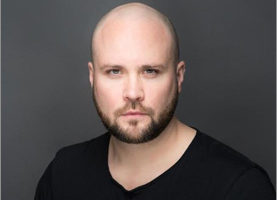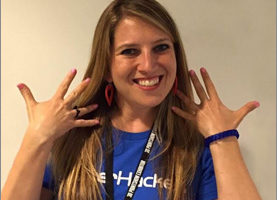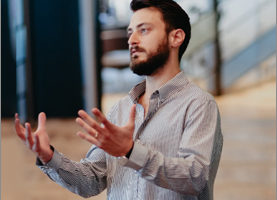In this podcast, Katie Hasson, PhD, Program Director, Center for Genetics and Society, delivers an interesting overview of the current state of gene editing, and the ethical and legislative issues that pertain to human biotechnologies.
As the Program Director on Genetic Justice for the Center for Genetics and Society (geneticsandsociety.org), Hasson works to advance the conversation on gene editing and biotech. The Center for Genetics and Society is a nonprofit social justice organization that seeks to steer society toward a future in which human genetic and reproductive technologies will collectively benefit everyone in an ethical and safe manner.
Hasson outlines her role at the Center for Genetics and Society. She discusses where the current discourse is, regarding human gene editing, touching on groundbreaking advances such as CRISPR (clustered regular interspaced short palindromic repeats). Hasson explains how gene editing types differ, from treatments designed for actual patients to solve their existing medical issues, versus the more controversial gene editing that can affect traits of future generations. She discusses the many and various ethical and safety issues, social concerns, and the efforts the international community is making to come together on their thoughts and principles regarding these new technologies.
Also, there is this link for a session about CRISPR Consensus: https://www.youtube.com/playlist?list=PL29W0b7TmEDzaW1VsLHndZtBpoOlB5CmI
Richard Jacobs: Hello, this is Richard Jacobs with the future tech and future tech health podcast. My guest is Katie Hanson. She’s a Ph.D. She writes, speaks, researchers and teachers about the social and political aspects of human genetic and reproductive technologies. She’s part of the Center for genetic and society. And now we’re going to be talking about a lot of the thorny but interesting issues. Katie, thanks for coming.
Katie Hasson: Thanks for having me.
Richard Jacobs: Tell me what’s your work about? What are you focused on?
Katie Hasson: Well, let me tell you a little bit about the Center for genetics and society. We are a public interest nonprofit. We’re based in Berkeley, California. And what we’re focused on is trying to encourage responsible uses and effective governance of human genetic and assisted reproductive technologies. And within that, the main focus that we have is trying to bring a social justice perspective to public conversations around human biotechnologies. And here I’m the program director on genetic justice. My main focus is in our work around human gene editing and really focused on how we can bring more perspectives and more voices into the really urgent conversations that we need to be having and the society about how we want to use powerful biotechnology like human gene editing.
Richard Jacobs: So let’s see. What does the justice part of it, you know, well, I guess first, how is it being used today? What are the fears around the use and the near future in that?
Katie Hasson: So, there’s been conversations about how we should use human gene editing that has gone on for a long time, right? Really sense. The early two thousand back when the conversation was more around human cloning but in the past few years with the emergence of CRISPR and the different ways of using CRISPR gene editing, these conversations have really gotten much more prevalent and much more important. And there is a range of ways that a CRISPR and other forms of gene editing can be used on humans. And I think there’s a really important distinction to make right off the bat, which is about whether we’re talking about using gene editing in somatic cells, in the body of an actual patient to attempt to treat or perhaps cure an illness that they have. But this would be something that affects the cells in their bodies but is not passed on to future generations. So we call that MADEC gene editing or gene therapy. And the distinction is between that and germline gene editing, which is using CRISPR and other gene-editing tools on sperm or eggs or early embryos in a way that would make changes that would be throughout every cell in that person’s body and also pass onto future generations. So on the one hand for gene therapies, we’re talking about developing treatments for actual patients and in germline gene editing we’re talking about affecting the genetic makeup or perhaps the traits of future people, future generations. And that’s something that for a long time, many people have believed should really be a bright line that we don’t cross about how we use these technologies. But probably you and your listeners have heard in November of last year, there was an announcement by a scientist in China, John Clay who announced that there had been the birth of two babies whose genes had been edited in the embryo stage. So this was the announcement of the first CRISPR babies or genetically edited babies. And this has really intensified and sped up the conversations that we need to have about how we’ll be using these technologies. Some of the concerns are, I mean there are a number of technical and safety concerns. This is pretty new research and I don’t think really any scientists agree that it’s the right time to move forward with using this in human beings. There are just too many unknowns. We know about some of the ways that it can go wrong. A CRISPR can make off-target cuts that can make changes where it’s not supposed to or it can make the wrong kinds of changes at the target site. There are cases where not all of the cells are edited so that the resulting person would have a mix of cells that are edited and not edited and we don’t know what the effects of that would be on their health. And really we don’t know in a lot of ways what the effects would be. Once a baby is born, as they grow up, as they grow older, as this moves into the next generation and it’s not clear that there’s really an ethical way that we can find out, right. How could we really say that we know that this is safe and ready to be used in people? But beyond those safety concerns, there are a lot of social concerns and that’s the kind of thing that we are most concerned about here.
Richard Jacobs: What’s an example of some social concerns?
Katie Hasson: When we think about the proponents, people who want to go ahead with using germline gene editing the conversation is often around preventing disease, preventing genetic diseases from being passed on to future generations. And one of the things that’s frustrating about that conversation is that it often doesn’t include the alternatives that already exist. Many people support the goal of, for parents who know that they’re at risk of passing on a genetic disease to their offspring. Many people support helping them prevent that from happening. But we actually already have safe and effective ways of doing that when that seems like an inappropriate goal particularly through embryo screening or a process called preimplantation genetic diagnosis where parents could use IVF and screen the IVF embryos that they have and choose to only implant those that are not affected by the disorder that they’re concerned about passing on. And that’s something that would be effective in the vast majority of cases, although there are somewhere it wouldn’t happen. But so when we’re talking about the benefits and harms, it’s important to think about the alternatives that are already available.
Richard Jacobs: Okay. What are some of the ethical considerations? So people say they want to eradicate these diseases that can be inherited, but what are the reasons for people to do what they want to do?
Katie Hasson: I mean even that basic question isn’t entirely free of ethical concerns. Especially if we look at it from a disability rights perspective. There are many disabled people, people in the disability rights community who argue that the disability actually comes from the way that society treats people with a variety of embodiments. And that we shouldn’t necessarily assume that all of these things need to be fixed. Many people think of a disability as part of their identity even. And so I think that’s one thing to keep in mind even when we’re talking about screening or PGD. But the level of societal concern comes in when we think about who’s going to make decisions about how these technologies can be used. There’s no agreement across the board on what counts as a serious disease or where we would draw the line between something that was seen as having a therapeutic aim or something that is seen as designed to enhance the future person. And so there’s not full agreement on that and it brings up the question of how we would decide how this would be used in the future. And there really are a number of risks of these technologies. If germline gene editing were to be used in the reproductive context to change future generations that it would exacerbate the kinds of social inequalities that we already have in our society that are already quite vast. And we have to think do we want to embark on the use of this new technology that could make those inequalities even worse. By allowing those with wealth to have access to purported enhancements. Even if it’s not possible to produce the kinds of genetic enhancements of intelligence or appearance or athletics that often get talked about when the idea of designer babies is brought up. Even if it’s not possible to make those kinds of changes genetically. The idea that you could write it it’s very likely that the clinic would advertise these forms of enhancement to parents and parents who had attempted to have these edits made to their children would perhaps see their children differently. Educators might see them differently. The perception that there was some kind of enhancement and the belief that some people in society would be genetically enhanced can be very damaging that we can see that from the history of racism and eugenics in our society that are based around this basic belief that there are forms of biological superiority.
Richard Jacobs: Is the concern more to get therapies in people’s hands or is they concerned you limit the possibility of people being enhanced. But if the therapy is both?
Katie Hasson: Well, therapies that would be for patients, but these kinds of somatic gene therapies are something that most people support. The idea of stopping germline gene editing is not to stop any form of therapy. In terms of somatic gene therapies. I think many people support that going ahead as long as there’s full attention paid to making sure that they’re safe and they’re effective and that they’re accessible to people. The gene therapies that already exist are astoundingly expensive. And so there has to be some thought put into how those will be paid for and how we can make sure that everyone who needs them has access to them. And the question of enhancement definitely will come into play with those somatic gene therapies. And that’s something that probably needs to be discussed more. How are we going to make sure that these therapies are developed and decide which users will be allowed and which won’t? But I think because we’re talking in that case about only that individual and the risks and benefits that might come to that person it’s a very different question than whether we’re going to allow people to, alter the genes of future generations and in ways that could be passed on.
Richard Jacobs: I’m going, to put it bluntly, can’t get pregnant. So the only way to help them and go this one therapy that would change not just their somatic cells, but it would change their germline cells, the egg of the sperm in order to allow them to have a baby, which is fine for that instance. But then going forward, every time they have a baby, they would be able to, I mean, what would be the conundrum of doing that.
Katie Hasson: I think the conundrum is partly about making these changes with unknown effects. That could be passed down. We won’t know what the risks may turn out to be in those future generations.
Richard Jacobs: I guess there are two kinds, let’s say you can tell that the child you’re going to have is going to have down syndrome so you altered them so that they’re quote-unquote against back to normal versus the child. I mean I guess if you restore the thing is back to their normal state. That’s the one thing. But if you change things that affect the normal states those different from the normal states. There it seems like there’d be a lot more of a question of, we changed this, but how does it affect everything else versus just fixing an obvious defect.
Katie Hasson: Well, I think that I would not take that as an assumption. I think it is a part of normal variation for someone to have Down syndrome or to have a number of different kinds of embodiments. And when you start talking about just putting only returning things to what’s normal I mean that there’s a lot of assumptions that go into saying what is normal and it comes back to this question of one, who decides that, especially when there is such broad disagreement. I mean there are many people with a range of disabilities who feel that this really would increase discrimination against them in society to say that it should just be edited out the condition that they have and that makes it an important part of who they are. But also its sounds easier on the face of it to say, well, these kinds of interventions would be therapeutic and these would be an enhancement. But it gets much trickier when you start to drill down into what that would look like. Whereas the line between somatic therapies that only affect that one person and germline that affects future generations is an easier line to draw. But when you talk about correcting disease, it opens up the question of what about something like prevention or what about something that would reduce someone’s likelihood of getting a disease by a certain percentage? Can we call that surely therapy? Can we call that enhancement? And how are we going to make enforceable policy around a slippery distinction like that?
Richard Jacobs: Yeah, I see what you’re saying. Oh, I mean, all medicine itself, if I help someone with a condition they have by, could you say that’s an answer? You know, if someone has a cold, you can say that’s natural. And I gave them something to cure them with the cold. So are they enhanced and is that unjust that I help them?
Katie Hasson: I mean, I think that’s one kind of question, but I think it becomes different when you’re talking about you know, altering DNA, we’ll get into a different kind of category than, you know, the sample of eyeglasses that improved people’s vision. Or something like that.
Richard Jacobs: Maybe, I mean, I guess you could say anything where it’d be like that. Why should they be allowed to have eyeglasses and have an ant vision when other people don’t have them. But I know that there’s going like way far-field and then there’s stuff that’s more obvious. So I understand as you do the questions around a lot of stuff. But if someone has a condition where the average lifespan of them is going to be a third of what would normally happen or what’s the average and they’d be in horrible pain and have a disability, well maybe that seems like more of an obvious, maybe cystic fibrosis. There’s really no argument on it. It seems to be a horrible condition. I don’t know if there’s anyone that would want to keep it so there are questions around all this stuff. I understand what you’re saying.
Katie Hasson: But I think there is a choice that we could say, let’s focus on somatic therapies for people who are here and who have illnesses that would like to be treated if we decide it’s appropriate, let’s use the kinds of screening that we have, like PGD with IBS when parents know that they’re at risk of passing something on to their children, but let’s not move into intervening in the germline.
Richard Jacobs: Do you think it’s even controllable or is this just, yeah, we’d like to control it, but I don’t know if it’s even possible. What are your thoughts?
Katie Hasson: I don’t think that it’s, we can’t throw our hands up and say it’s inevitable. It’s going to happen anyway. I mean there are many countries that already have legislation that says that germline gene editing should be prohibited and having more international cooperation and laws would really go a long way towards having a clear stance out there. Even having laws prohibiting germline gene editing everywhere would not stop every case of it happening. And that’s unrealistic. But having Mullahs sends a clear message about what we think should and should not be allowed and can have penalties attached to it for people who violate it. So it couldn’t be stopped in 100% of cases. I mean, we’ve already seen that. That’s true, but it’s not the case then that we could not collectively decide to have legislation about it. We have laws for many things that do get broken, but we don’t get rid of or say that there’s no point in having laws about it.
Richard Jacobs: Right. I gotcha. I think a good line initially would be sematic versus germline alterations.
Katie Hasson: Yeah. I think that is the one that conceptually and practically the easiest one to hold. And somatic gene therapies do offer a lot of promise. So it’s good to keep that explanation going.
Richard Jacobs: Okay. Gotcha. Is there an international organization that’s going to make these rules? That sounds like there should be one if you want it all around the world, the ones that are happening worldwide or are bodies forming or who’s running them?
Katie Hasson: Yeah, I mean there are a number of countries where on the national level they’ve made legislation and there is at least one international treaty of the Oviedo convention, it’s from the council of Europe. And at least 29 countries have ratified that. And it says that germline gene editing for reproduction is prohibited. And then there are a number of international efforts to talk about how this should be regulated. There’s a panel that’s meeting through the world health organization currently and there’s an international commission hosted jointly by the National Academy of sciences in the US and the Royal Society in the UK. That’s pulled together members from a number of countries too. To think about what a framework for using germline gene editing might look like. If society decides that it should go forward. The WHO panel is looking more broadly at what should be done. So those are two efforts that are going on, but you know, we would really like to see an even broader conversation. I mean, this is something that we’re talking about that could potentially affect everybody. If we’re talking about altering the human genome for future generations in ways that would be passed down and become a part of the general gene pool then it’s something that affects all humans, basically, all of us. And so it would really be something that there should be a way for the broadest possible conversation to happen to bring more people in, more voices. So far the conversations are mainly happening among elite scientists, bioethics professionals, sometimes broader groups of academics, but we’d really like to see more of a public conversation happening. And in particular, one that brings in voices from civil society, it groups that are already thinking and talking and working on issues of discrimination in our society and ways to repair it will have a particularly unique perspective on these questions. And I think should be brought into the conversation as well.
Richard Jacobs: Oh, voices and talks and liberate, again, is this just in the US or is it worldwide? And what’s the focus, first here and then worldwide, and we can rule on X, Y, and Z. But if other countries don’t rule the same then what, but how would you make this a phenomenon that actually would be enforceable?
Katie Hasson: Yeah, I think that it really does need to be worldwide, which will obviously be a challenge, but, it’s an important enough question that we should sort of put time and creativity. And so thinking about how we could make it happen. But a number of scientists and organizations have already been calling for a worldwide moratorium on reproductive uses of germline gene editing. So the idea that we save, let’s stop for now so that we have time to have these conversations in a really thorough Broadway. So we can figure out how we can bring in people around the world, how we can make sure that there’s international cooperation in these rules. But if scientists, they’re racing to move ahead, we lose time to have that conversation, whereas saying, let’s stop for now while we decide really gives more space and time for that to take place. It is a complicated question of how we will come up with a way that is actually worldwide and cooperative and enforceable. But we’ll need some time to think about it and work it out.
Richard Jacobs: What’s the pathway that you see? What are the steps right now that you guys are taking to try to get this moving?
Katie Hasson: One of the things that we do is we work with other organizations. We work with reproductive justice organizations, disability rights, LGBTQ, environmental groups and a number of others to sort of bring this issue to them and kind of bring their perspective more to the public. We are interested in things like the US Senate resolution that was introduced earlier this year that called for broad public debate and at least was bringing the attention of the Senate and of our elected leaders to this issue in a way that encourages international cooperation and broad conversation in the public. So there’s are two promising things. We would like to see the efforts that are already underway, like the WHO and the national academies, client groups too, to have a more kind of robust public conversation around that as well.
Richard Jacobs: For listeners, how can they get involved in the conversation? How can they find out more?
Katie Hasson: Our website geneticsandsociety.org has a lot of information. We follow the news very closely and we post a lot of news. We have writing on our blog, which is called BioPolitical time. You can also follow us on Twitter @C_G_S and you can find us on Facebook as well. You can also join our email list and get our monthly newsletter.
Richard Jacobs: Okay. Excellent. So the best way is to go to the website or go on social media and then in the show notes, we’ll put details about the meeting that’s coming up with a few weeks and excellent. Okay. Thank you for coming.
Katie Hasson: Oh yeah. Thank you for your time. Thank you for the conversation.
Podcast: Play in new window | Download | Embed











